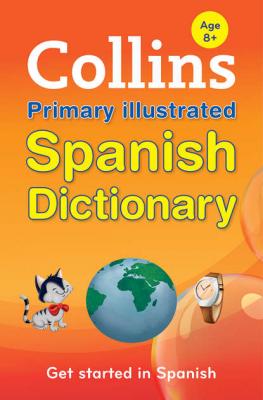Collins Primary Dictionaries. Collins Dictionaries
Чтение книги онлайн.
Читать онлайн книгу Collins Primary Dictionaries - Collins Dictionaries страница 2

Access to a dictionary which is pitched at an appropriate level is a vital part of the language-learning process. The content of this dictionary has been carefully selected to reflect current trends in primary education and help children with acquiring basic language-learning skills.
The key aims of the Collins Primary Illustrated Spanish Dictionary are:
• to develop both language skills in Spanish and language learning skills in general
• to cover the four key areas of language attainment: listening, speaking, reading and writing
• to reinforce key aspects of the language by the use of notes and feature boxes throughout the entries
• to extend cultural awareness by providing information about Spain, especially where traditions differ from those in Britain
The Collins Primary Illustrated Spanish Dictionary supports language learning in a number of specific ways:
• it develops children’s knowledge of how language works by encouraging them to understand, analyse and use simple aspects of grammar
• it develops children’s individual learning skills by using a wide range of notes that explain things in a simple but interesting way
• it enables children to make comparisons between Spanish and English by encouraging them to explore the similarities and differences between the two languages and cultures
• it introduces young learners to all the basic elements of a bilingual dictionary and provides detailed instructions on how to get the most out of using the dictionary
The Collins Primary Illustrated Spanish Dictionary is presented in an easy-to-use format which is intended to appeal to children of primary school age. It provides lots of simple, relevant examples and tips on how to remember words, and how to avoid some of the pitfalls of translation. It also features key phrases, illustrations and information about life in Spain, making it an invaluable and exciting new resource.
Step one:
Pick the right side
Remember there are two halves to the dictionary. If you want to know what a Spanish word means, look in the first half of the dictionary.
If you want to translate an English word into Spanish, look in the second half, which is English-Spanish. It comes after the supplement in the middle of the dictionary.
1 Which of these words would you look up on the Spanish-English side of the dictionary?
ver brother horse teléfono
2 Look at page 51 of the dictionary. Is this the Spanish side or the English side? How can you tell?
3 Look at page 150 of the dictionary. What is shown at the top of the page, down the side?
4 Is invite the first or the last word on page 437?
Remember that you do not read across the whole page in a dictionary – you have to read down the columns.
5 Which word comes immediately after aburrido?
Step two:
Find the right word
A B C D E F G H I J K L M N O P Q R S T U V W X Y Z
Words are in alphabetical order in the dictionary – like names in the phone book, and in a school register. The alphabet is shown down the edge of each page of the dictionary. You can sort words into alphabetical order by looking at the first letter of each word.
6 Can you put these names in alphabetical order?
María, Isabel, Juan, Jorge, David, Arturo, Carmen
When two words start with the same letter, look at their second letters.
7 In alphabetical order which comes first – Juan or Jorge?
8 This is the order of the days of the week on a calendar:
Monday, Tuesday, Wednesday, Thursday, Friday, Saturday, Sunday
Which day comes first in a dictionary? Which comes last?
9 Thursday comes before Tuesday in a dictionary. Why?
10 Put the seven days of the week into alphabetical order. If the first letters are the same, and the second letters are the same, look at the third letters.
11 June, July, August: which comes last in the dictionary?
Step three:
Pick the right translation
The translations are easy to spot in this dictionary because they are blue on the English-Spanish side and red on the Spanish-English side.
Spanish words can be masculine or feminine, and singular or plural. In the dictionary you will come across the abbreviations masc and fem, which tell you the gender of a Spanish word. PL tells you the word is plural. The dictionary also shows you the Spanish word for ‘the’ (this can be el, la, los or las). In the Language plus supplement, NOUN is abbreviated to N and ADJECTIVE is abbreviated to ADJ.
When you look up ‘doll’ you can see that the word for ‘doll’ in Spanish is muñeca. You can tell that the Spanish word for ‘doll’ is feminine because it is given with la and the dictionary says that it is ‘fem ’ (feminine).
So ‘the doll’ is la muñeca and ‘a doll’ would be una muñeca.
Sometimes there is more than one translation, and each one has a number. If there is more than one translation, don’t just pick the first one! Check to see which is the right one.
12 Which is the Spanish word for a ball that you kick – la pelota or el balón? Look for the clue.
ball NOUN
1 la pelota fem (for tennis, golf, cricket) Hit the ball! ¡Dale a la pelota!
2 el balón masc (PL los balones) (for football,